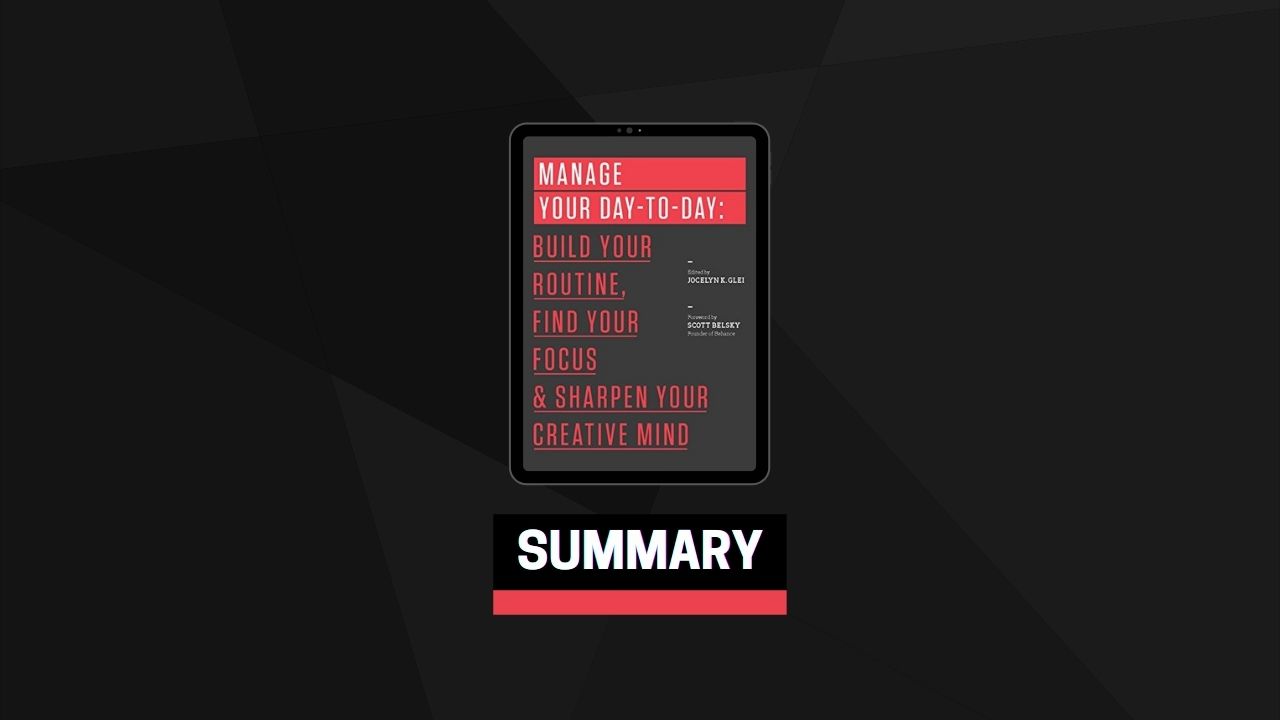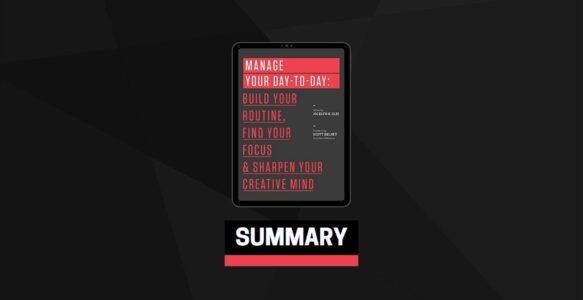Laying the Groundwork for an Effective Routine
If you want to create something worthwhile with your life, you need to draw a line between the world’s demands and your own ambitions. Yes, we all have bills to pay and obligations to satisfy. But for most of us there’s a wide gray area between the have-tos and want-tos in our lives. If you’re not careful, that area will fill up with e-mail, meetings, and the requests of others, leaving no room for the work you consider important.
Start with the rhythm of your energy levels. Certain times of day are especially conducive to focused creativity, thanks to circadian rhythms of arousal and mental alertness. Notice when you seem to have the most energy during the day, and dedicate those valuable periods to your most important creative work. Never book a meeting during this time if you can help it. And don’t waste any of it on administrative work!
Use creative triggers. Stick to the same tools, the same surroundings, even the same background music, so that they become associative triggers for you to enter your creative zone.
Manage to-do list creep. Limit your daily to-do list. A 3” × 3” Post-it is perfect—if you can’t fit everything on a list that size, how will you do it all in one day? If you keep adding to your to-do list during the day, you will never finish—and your motivation will plummet. Most things can wait till tomorrow. So let them.
Capture every commitment. Train yourself to record every commitment you make (to yourself or others) somewhere that will make it impossible to forget. This will help you respond to requests more efficiently and make you a better collaborator. More important, it will give you peace of mind—when you are confident that everything has been captured reliably, you can focus on the task at hand.
Establish hard edges in your day. Set a start time and a finish time for your workday—even if you work alone. Dedicate different times of day to different activities: creative work, meetings, correspondence, administrative work, and so on. These hard edges keep tasks from taking longer than they need to and encroaching on your other important work. They also help you avoid workaholism, which is far less productive than it looks.
A truly effective routine is always personal—a snug fit with your own talent and inclinations. So experiment with these building blocks and notice which combination gives you the best foundation for doing your best work. You’ll know it’s effective when your daily schedule starts to feel less like a mundane routine and more like a creative ritual.
Harnessing the Power of Frequency
We tend to overestimate what we can do in a short period, and underestimate what we can do over a long period, provided we work slowly and consistently. Anthony Trollope, the nineteenth-century writer who managed to be a prolific novelist while also revolutionizing the British postal system, observed, “A small daily task, if it be really daily, will beat the labours of a spasmodic Hercules.” Over the long run, the unglamorous habit of frequency fosters both productivity and creativity.
Frequency makes starting easier. Getting started is always a challenge. It’s hard to start a project from scratch, and it’s also hard each time you re-enter a project after a break. By working every day, you keep your momentum going. You never have time to feel detached from the process. You never forget your place, and you never need to waste time reviewing your work to get back up to speed or reminding yourself what you’ve already done. Because your project is fresh in your mind, it’s easy to pick up where you left off.
Frequency sparks creativity. You might be thinking, “Having to work frequently, whether or not I feel inspired, will force me to lower my standards.” In my experience, the effect is just the opposite. Often folks achieve their best work by grinding out the product. Creativity arises from a constant churn of ideas, and one of the easiest ways to encourage that fertile froth is to keep your mind engaged with your project. When you work regularly, inspiration strikes regularly.
Frequency is a realistic approach. Frequency is helpful when you’re working on a creative project on the side, with pressing obligations from a job or your family. Instead of feeling perpetually frustrated that you don’t have any time for your project, you make yourself make time, every day. If you do a little bit each day, you can get a lot done over the course of months and years (see above). Also, it’s true that frequency doesn’t have to be a daily frequency; what’s most important is consistency. The more widely spaced your work times, however, the less you reap all of these benefits.
Making Room for Solitude
In 1845, Henry David Thoreau set out for the woods near Walden Pond to find solitude, for his thoughts and his writing. He wanted to get away from the business and noise of nineteenth-century city life.
He wrote, “I went to the woods because I wished to live deliberately, to front only the essential facts of life, and see if I could not learn what it had to teach, and not, when I came to die, discover that I had not lived.”
SIMPLE SOLITUDE PRACTICE
Most people are uncomfortable with the idea of solitude because it means facing yourself without distractions. Practice can make solitude less scary, and will help you become comfortable with the prospect of finding it on a regular basis.
One amazing way to practice is a simple meditation session once a day. Meditation doesn’t have to be mystical or complicated: at heart, it’s simply sitting and doing nothing else for at least a few minutes. A great place to build this into your daily routine is as soon as you wake up—get up, drink some water, and then sit and meditate for five, ten, or even twenty minutes before you start your day.
What’s the point of sitting? There is no point—sitting is the point. You’re not doing it to reduce stress, gain enlightenment, or learn more about yourself—though all these things might happen—but to practice just sitting. In doing so, you are practicing being alone, and doing nothing but what you’re doing. This is essential.
Scheduling in Time for Creative Thinking
Start with small blocks of focused time and then gradually work yourself up to longer durations. A good rule of thumb is to begin with an hour at a time, then add fifteen minutes to each session every two weeks. The key, however, is to never allow distraction. If you give in and quickly check Facebook, cancel the whole block and try again later. Your mind can never come to believe that even a little bit of distraction is okay during these blocks.
Tackle a clearly identified and isolated task. If you have to write an article, for example, do the research ahead of time, so that when you get to your focus block you can put your word processor in fullscreen mode and turn your entire attention to your prose.
Consider using a different location for these blocks. Move to a different room, or a library, or even a quiet place outside to perform your focused work. When possible, do your work with pen and paper to avoid even the possibility of online distraction.
The battle between focus and distraction is a serious problem—both to the competitiveness of our companies and to our own sanity. The amount of value lost to unchecked use of convenient but distracting work habits is staggering. The focus block method described above does not fix this problem, but it does give you a way to push back against its worst excesses, systematically producing important creative work even when your environment seems designed to thwart this goal.
Learning to Create Amidst Chaos
Leigh Michaels, prolific author of more than eighty romance novels, once said that “waiting for inspiration to write is like standing at the airport waiting for a train.” Conditions to produce one’s craft are rarely ideal, and waiting for everything to be perfect is almost always an exercise in procrastination.
Most celebrated creative minds don’t have wealthy patrons who support their lives and proclivities regardless of what they produce. Musicians have day jobs, poets are also professors, and feature filmmakers shoot commercials on the side. Like it or not, we are constantly forced to juggle tasks and battle unwanted distractions—to truly set ourselves apart, we must learn to be creative amidst chaos.
POSITIVE DISTRACTION
Negative distractions that interfere with creative work can come in many forms: the television set, undone chores, social media, e-mail, coworkers who want to gossip, anxieties, self-doubt. Removing oneself from all of this interference is theoretically possible.
In the Stanford study children were given an option to eat one marshmallow right away, or wait a few minutes and receive two marshmallows. The children who were able to delay their gratification employed positive distraction techniques to be successful. Some children sang; others kicked the table; they simply did whatever they needed to do to get their minds focused on something other than the marshmallows.
There are many ways to use positive distraction techniques for more than just resisting marshmallows. Set a timer and race the clock to complete a task. Tie unrelated rewards to accomplishments—get a drink from the break room or log on to social media for three minutes after reaching a milestone. Write down every invading and negatively distracting thought and schedule a ten-minute review session later in the day to focus on these anxieties and lay them to rest.
Getting Unstuck
When working on a large creative project, you may reach a point where your initial inspiration runs dry. You find it harder and harder to muster any enthusiasm for the work, let alone original ideas.
The Adventures of Tom Sawyer is regarded as one of the great American novels, but at one point its author despaired of finishing it. In his Autobiography, Mark Twain describes reaching a point in the story where he felt unable to go on: “My tank had run dry.” He abandoned it for two years and turned his mind to other things. When he eventually picked up the manuscript again, he made the “great discovery” that the “tank” of his imagination had refilled itself in the meantime, and he was able to complete the story. This discovery was a turning point in Twain’s writing career: he learned to watch out for the point in each subsequent book when his tank ran dry, and to take a break before finishing it.
Take a leaf out of Twain’s book. Look out for the telltale signs that your tank is empty, and use them as a cue to take a break and let your unconscious take the strain. Relax or apply yourself to a completely different type of project. You may not have two years to set your project aside if a deadline is looming, but even a short break can work wonders when you’re running low on inspiration.


